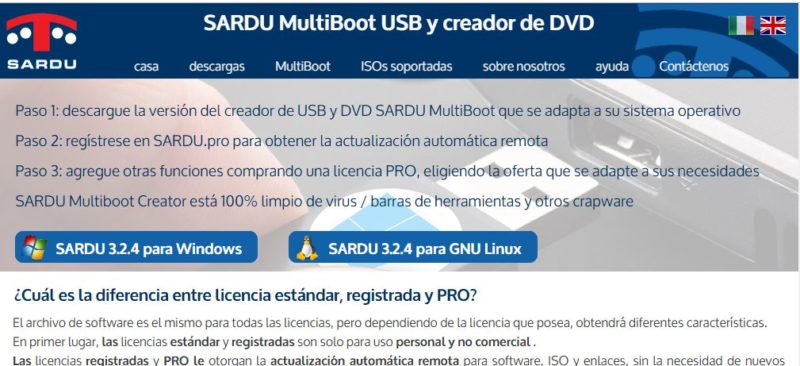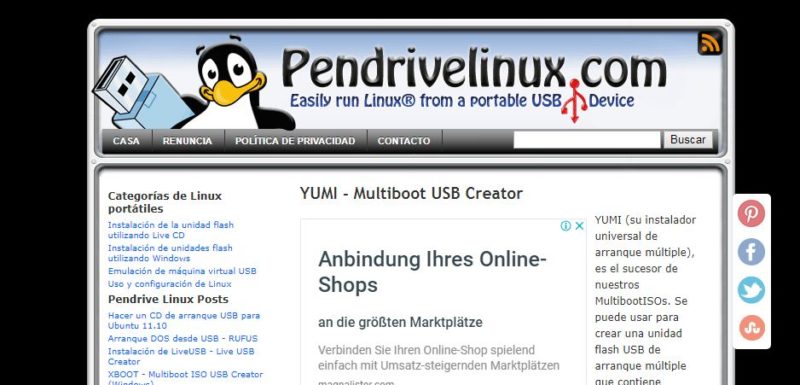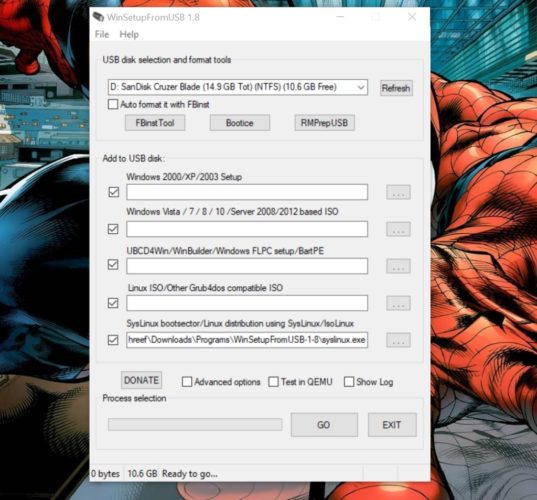
It is well known to create an external disk in this case a USB to install an operating system , but you know that instead of doing such a long process to install only an operating system on your USB Can you install two, three or more creating a multi-boot USB?
Well, the truth is that although its process seems very complicated is very simple you just have to use the right software for this process, so we bring you the best tools so you can Easy and simple to create an external multiboot disk or well known in Spanish as multiboot.
We will teach you with the help of SARDU Software how to create your multi-boot USB in a few steps. Many are those who say that it is very complicated but if you are here it is to discover it for yourself, do not say more and come on .
Index:
Steps to create a USB Multi-boot or Multiboot 8, in Windows 10 and Linux
Installing a multi-boot operating system has always been a headache , due to the different risks that are taken during the process. That is why we bring you a step-by-step guide on how to do it. Before starting, we need to download the program to use.
The name of the software is SARDU and to download it you must click on the links below . When the download is complete, locate the place where it was saved and run it as an administrator.
Download Sardu for Windows
Download Sardu for Linux
Already started the program and downloaded, we proceed with the step by step to create a USB Multiboot:
Choose operating systems
A list of programs that you can install on the USB is located in the left column. You are going to select the operating system (OS) that you want to install by clicking on it. In our case we will install Linux , for this reason we click on the Linux icon and select the distributions we want to use . The operating systems are compressed into an ISO file that must be decoded and installed correctly in order to achieve our goal.
As you can see in the image three different icons are shown:

By clicking on the red icon the ISO file is selected. Clearly it must be downloaded to our hard drive, if you don’t have it you can download it by double clicking on the blue icon that contains an arrow , to add it to the download list.
We manually downloaded Kali Linux and Debian, and Sardu was responsible for downloading Ubuntu. To download you must click on the «Download» icon, which is located in the left column, and then click on the «Start» button.

At the end of the download we return to the Linux list, select the OS and press the red button to search for it on a hard disk, to have a different name than the one that SARDU demands is only renamed and the problem is solved.
Also install Windows 10
You can also install Windows 10 and other Windows OS such as Windows 7, 8 and 8.1 but you must first obtain the ISO image, and for this follow the instructions below:
Download MediaCreationTool
- First we have to download the media creation tool and run it. When it is started, we select the option Create a means of installation for another PC and click on «Next». There select the OS that we are going to use and click on the option «ISO File» .

- At the end of this process we will see in the indicated directory the ISO image. Then we return to SURDU again, click on the «Windows» icon located in the left column and click on “installer10”, and locate the ISO file to install it, as in the previous cases if it has a different name than the one required by SURDU we only rename the file.

Install on USB
Already fulfilling the previous step, we proceed to copy and decode them in the pendrive to create the multi-boot USB with Linux and Windows 10 , but we have to take into account that for this step the pendrive that we must use must have a capacity greater than 4 GB. In addition, it must also be formatted in FAT32, as it is a requirement for SARDU to recognize it.
Once this is done the steps to follow are:
- Enter the pendrive in the computer and return to SARDU, look in the right column and click on “Search USB” , there will appear some discs and select the one of our pendrive.

- Then in the right column we can see the option “Create USB SARDU” select it to start the installation. This process may take several minutes, but it all depends on the weight of the operating systems we want to install.

MultiStart from USB
For this step we must turn off the computer which we are going to install the OS, enter the Pendrive , turn it on again and press the F11 key or the one that allows us to boot A computer from a USB. When you do this, the SARDU menu should be started instead of the operating system that we have installed at the moment.
When properly fulfilling the previous step, we will see a menu that allows us to select tools as well as the Linux or Windows operating systems that we have included. If we have included the Windows 10 installer, it may automatically exit before the menu . Although if we don’t want to install it, we just cancel the installation to recover the boot menu.
In our case we check that the three Linux systems of the test are listed: Kali, Debian and Ubuntu. Finally we choose the OS we want to install , and then our computer will start with the OS that we have just installed.
What are the best programs to create a USB Multiboot from 0?
You need the help of a program which must be installed on our computer in order to create a multiboot USB, there are different programs which can be used for this however, here we will show the most used and recommended .
SARDU

This is the software we use to make our multiboot pendrive, for this reason we attest that this is one of the best programs to create a multi-boot USB that you will see today . This can be used to install up to 50 live operating systems on any external disk (USB or DVD), in addition it also fulfills the virus detection and removal function and you can download a free and paid version.
Easy2Boot

Download Easy2Boot for Windows
Download Easy2Boot for Linux
We personally consider that this is the second program to create a most used multi-boot USB in the world , since it offers functions and meets adequate characteristics to be able to make an external multiboot disk without so much entanglement or complication .
With the use of this program we will not need to format our neck again because he does it for us, as well as decoding any compressed file like .ISO; .IMA; IMG; .VHD; .WIM; Winbuilder; WinPE ISO; Windows Install ISOs and others, as well as diagnostics, repair software, antivirus cleaner much more.
YUMI –Multiboot Creator

Download YUMI –Multiboot Creator
This is a tool that is currently under construction, however it works in some distributions currently something that allows its use, this software uses sislinux to boot extracted distributions stored in the USB device, and uses grub to boot multiple files ISO from a USB . It has a fairly simple and easy to use system, its features are constantly improving and there are always updates on it.
WinSetupFromUSB

Download WinSetupFromUSB
This is a fairly simple program compatible with all versions of Windows, and it is also compatible with Linux and BSD. It has a virus tracking system that gives us security through its use preventing So our disk is contaminated, just as it offers disk repair for any case. This program may not have much styling but it fulfills the promised functions.
MultibootUSB

Download MultibootUSB
It is a fairly simple software which can be used to create a multiboot USB with different OS such as Windows, Linux and others. The only disadvantage of this powerful software that is only compatible with Linux Operating Systems , so it doesn’t seem fair to many Windows users.
It offers features that will keep our PC safe and clean of all viruses as well as take care of our pendrive when connected to our computer.
XBoot

Download XBoot
It is another software with a compatible ease of use in Windows only, which allows you to create a multi-boot USB. Among its features we can say that it uses Fat32 and NFTS file formats although it is highly recommended by experts that Fat32 be used during installation .
WinUSB

Download WinUSB
It is one of the easiest tools to use to create a multi-boot USB, it is free of charge on its official site and it is best that its process is only three steps .
- Choose the unit.
- Indicate the OS in ISO files to use.
- Choose the version you want to install and go.
In this way this program is also considered the fastest in the process for being one that has less click to achieve the goal.